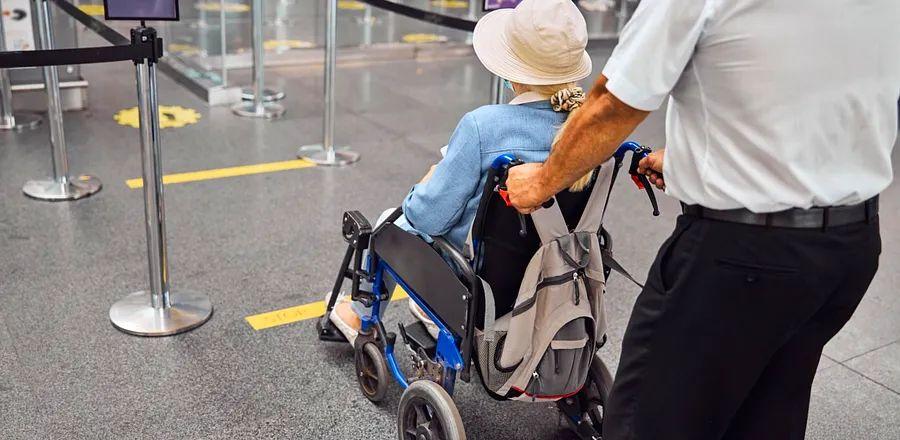United Launches New Search Tool for Passengers Using Wheelchairs

For the approximately 5.5 million Americans who rely on wheelchairs, flying is about to become a little more accessible—at least with one U.S. airline. United Airlines has announced a forthcoming search filter on its website designed to enhance travel equity for those with mobility devices.
Set to debut in early 2024, this filter will enable customers to enter the specific dimensions of their wheelchair during their flight search. The site will then display all flights from their departure city to their destination that can accommodate and safely transport their wheelchair. (Cargo hold door sizes vary, and not all can accommodate larger motorized wheelchairs.)
“By providing customers with a straightforward way to verify if their personal wheelchair fits on a specific aircraft, we can offer them the reassurance they deserve when flying with us,” said Linda Jojo, United's executive vice president and chief customer officer, in a statement. “Additionally, gathering this information in advance allows our team to handle these special items with the necessary care and attention.”
If the aircraft for a traveler’s desired route isn’t suitable for their wheelchair, United stated that travelers can book a compatible itinerary, and the airline will refund the fare difference if it is higher. Both flights must be for the same route on the same day to be eligible for the reimbursement, and travelers will need to submit a form after their flight to receive the funds.
In a statement, United announced that the company and its Accessible Travel Advisory Board will initiate a six-month pilot program at George Bush Intercontinental Airport in Houston to explore better ways to assist customers if their mobility device is damaged or delayed during travel.
United is rolling out these initiatives following a thorough investigation by the U.S. Department of Transportation (DOT), prompted by a complaint regarding the airline's handling of a passenger’s wheelchair, as stated by the DOT.
The passenger in question was Engracia Figueroa, a disability rights advocate and president of Communities Actively Living Independent and Free. Her custom wheelchair, valued at $30,000 and designed for her spinal cord injury and leg amputation, was damaged on a United Airlines flight in 2021, according to statements from the disability rights organization Hand in Hand. Figueroa passed away three months later, with Hand in Hand claiming that her death was due to sitting in a damaged manual wheelchair while awaiting a loaner motorized wheelchair at Los Angeles International Airport after her personal wheelchair was destroyed. Hand in Hand reported that because Figueroa couldn’t balance without her custom wheelchair, she developed a pressure sore that became infected. Despite medical attempts to treat the infected tissue and bone, Figueroa did not survive.
Airlines damage thousands of wheelchairs and mobility scooters annually. In August 2023 alone, U.S. airlines mishandled over 1,100 wheelchairs and scooters, according to the latest Air Travel Consumer Report from the DOT’s Office of Aviation Consumer Protection. To put this in perspective, that represents 1.52 percent of all wheelchairs and scooters that traveled that month.
“Everyone should be able to travel safely and with dignity, and I’m pleased that United is taking measures to enhance their services for passengers using wheelchairs,” stated U.S. Transportation Secretary Pete Buttigieg regarding the changes being implemented by United for wheelchair users. Buttigieg further noted, “We at the U.S. Department of Transportation will continue our efforts to make air travel safer and more accessible for people with disabilities, as well as for the millions of Americans who board planes daily.”
According to the Department of Transportation, upcoming changes include the installation of additional wheelchair ramps and accessible restrooms in airport terminals, a mandate for airlines to ensure lavatories on all new single-aisle planes are accessible, and the establishment of regulations requiring enhanced training for airline staff to assist passengers with disabilities. These changes will also permit passengers to remain in their own wheelchairs while flying.
This isn’t the only effort by airlines to improve accessibility for passengers with disabilities this year. In June, Delta unveiled a prototype for a groundbreaking airplane seat that enables wheelchair users to remain in their wheelchairs during flights. Additionally, United became the first airline to incorporate Braille signage in some of its aircraft, facilitating easier navigation for visually impaired passengers. The airline aims to retrofit its entire fleet with this signage by 2027.

1

2

3

4

5
Evaluation :
5/5